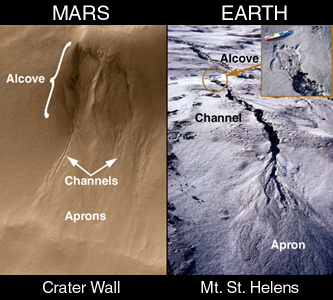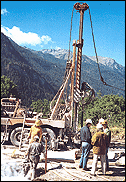Introduction
Definition of Life
Motivation
Preliminary
Steps
Present Life
Past Life
Geological Survey
Sample Collection
Spectroscopic Analysis
Organic Analysis
Biology Experiments
Thin Section
Isotope Analysis
Experimental Design
Drill
The drill will be used to obtain a core sample of the underground rock layers on Mars. Such a core will enable us to study the present underground rock compositions, and give us clues to the recent geological past on Mars.
The drill will be 100 meters deep, and will have a 2cm diameter core. Recent observations of data from the MOC-camera on the Mars Global Surveyor suggest the presence of water outflows that are hypothized to originate 100 m underground (Malin, et.al. 2000), see image below.
The rotary air blast mechanism will be used to drill. This is
a simple and economic technique that is suited for depths of up to 100 meters. The
mass estimate for this drilling technology is 200 kg. It will be
deployed by two human operators using the transportation rover. Drilling Specifications Drilling References
Companies Specializing in Geological Drilling

Malin Space Science Systems, 2000

Foraco Drilling Company,
2000
Hawaiian Scientific Drilling Project
RRindfuss Drilling
Foraco
Environmental Mechanics
Falcon GDP, Inc.